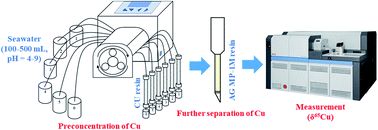Use of a Cu-selective resin for Cu preconcentration from seawater prior to its isotopic analysis by MC-ICP-MS
Abstract
Determination of the copper (Cu) isotopic composition (δ65Cu) of seawater is difficult due to low Cu concentrations (0.3 to 7.6 nmol kg−1) and high salt content. Here, we present a new procedure for matrix separation and Cu preconcentration based on a combination of a Cu-selective resin column and an AG MP-1M anion exchange resin column. The Cu-selective resin shows a quantitative recovery of 102.3 ± 5.0% (mean, 2SD, n = 5) and high selectivity for Cu over the main cations (Na, Mg, K and Ca) in seawater, efficiently preconcentrating Cu in seawater. Due to the hydrophobic nature of the Cu-selective resin, it was necessary to accelerate the preconcentration process using a peristaltic pump. Subsequently, an anion exchange resin was used to acquire a pure Cu fraction and thus ensure the accurate determination of seawater δ65Cu. Seawater samples can be loaded on the Cu-selective resin column under a wide range of pH conditions (from pH = 4 to 9) instead of the narrow acidic pH range required in previous studies. The whole procedure is simple and has a low blank of 1.28 ± 0.48 ng Cu (n = 4). Results obtained from a series of doping experiments of seawater with an Alfa Cu standard confirmed the accuracy of the proposed method.



 Please wait while we load your content...
Please wait while we load your content...